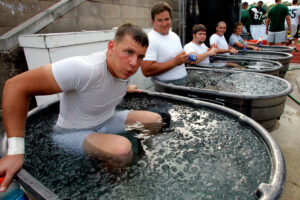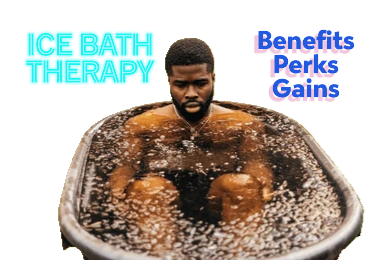After an intense weightlifting session, your muscles are fatigued, inflamed, and in need of recovery. Ice bath therapy, also known as cold-water immersion, has gained popularity among athletes and fitness enthusiasts as a method to enhance recovery, reduce soreness, and improve overall performance. This article explores the science behind ice bath therapy, its benefits, and how to incorporate it into your post-workout routine.
What Is Ice Bath Therapy?
Ice bath therapy involves immersing your body in cold water, typically ranging from 50°F to 59°F (10°C to 15°C), for a specific period. The cold temperature constricts blood vessels, reduces inflammation, and promotes recovery. Athletes use it to minimize muscle damage and speed up the healing process.
Benefits of Ice Bath Therapy for Weightlifters
1. Reduces Muscle Soreness
- Intense weightlifting causes microtears in muscle fibers, leading to Delayed Onset Muscle Soreness (DOMS).
- Ice baths decrease muscle inflammation, reducing soreness and stiffness.
2. Enhances Recovery
- Cold immersion flushes out metabolic waste, like lactic acid, by constricting and dilating blood vessels.
- Promotes fresh blood flow, bringing nutrients and oxygen to muscle tissues.
3. Improves Performance
- Faster recovery means you can train harder and more frequently.
- Regular use of ice baths helps maintain peak performance levels.
4. Reduces Swelling and Inflammation
- Heavy lifting often leads to localized swelling.
- Cold therapy minimizes inflammation, helping muscles and joints feel less puffy or strained.
5. Boosts Mental Toughness
- Sitting in icy water isn’t ea
 sy—it’s a mental challenge.
sy—it’s a mental challenge. - Regular practice builds resilience, focus, and the ability to manage discomfort.
The Science Behind Ice Bath Therapy
Ice bath therapy works through a combination of physiological responses:
- Vasoconstriction: Cold temperatures narrow blood vessels, reducing blood flow to inflamed areas.
- Reduced Nerve Activity: Decreases nerve signals related to pain, offering immediate relief.
- Increased Circulation Post-Bath: After emerging, blood flow rushes back to the muscles, accelerating healing and nutrient delivery.
How to Take an Ice Bath
- Prepare the Bath
- Fill a tub with cold water.
- Add ice to lower the temperature to 50°F–59°F (10°C–15°C).
- Duration
- Stay in the bath for 10–15 minutes.
- Avoid prolonged exposure to prevent cold-related injuries.
- Immerse your lower body completely.
- For upper-body recovery, position yourself to submerge the arms and shoulders.
- Post-Bath
- Dry off and dress warmly.
- Follow up with light activity to rewarm the body gradually.
When to Use Ice Baths
- Post-Workout: After high-intensity or heavy lifting sessions.
- After Competition: To recover quickly for future events.
- During Training Blocks: When training volume is high and recovery is critical.
Potential Risks and Precautions
While ice bath therapy is generally safe, it’s not for everyone. Consider these precautions:
- Avoid Prolonged Exposure: Staying in cold water for too long can lead to hypothermia or frostbite.
- Consult a Doctor: If you have cardiovascular issues or other medical conditions, seek advice before using ice baths.
- Balance Usage: Overusing ice baths may blunt muscle growth by reducing inflammation too much. Reserve them for intense sessions or recovery needs.
Alternatives to Ice Bath Therapy
If ice baths aren’t for you, other recovery methods can also be effective:
- Foam Rolling: Relieves muscle tension and improves blood flow.
- Compression Gear: Helps reduce swelling and improve circulation.
- Active Recovery: Light exercises like walking or yoga aid recovery.
- Contrast Therapy: Alternating hot and cold water immersion stimulates circulation.
Ice Baths and Muscle  Growth: What You Need to Know
Growth: What You Need to Know
While ice baths are excellent for recovery, excessive use may interfere with hypertrophy (muscle growth).
- Why? Inflammation is a natural part of muscle repair and growth. Overusing ice baths might suppress this process.
- Solution: Use ice baths strategically—after competitions or particularly grueling workouts, not after every session.
Combining Ice Baths with Other Recovery Methods
Maximize recovery by incorporating ice baths into a comprehensive recovery routine:
- Hydration: Replenish fluids lost during workouts.
- Protein Intake: Consume protein-rich meals or shakes to support muscle repair.
- Stretching: Perform static stretches to improve flexibility and reduce stiffness.
- Sleep: Prioritize 7–9 hours of quality sleep for optimal recovery.

Who Benefits Most from Ice Bath Therapy?
- Weightlifters and Bodybuilders: Recover faster between sessions.
- Endurance Athletes: Alleviate soreness from long training hours.
- High-Performance Athletes: Stay in top shape during intense training cycles.
Conclusion: Recover Smarter, Not Harder
Ice bath therapy is a powerful recovery tool for weightlifters seeking to reduce soreness, enhance recovery, and improve performance. While not necessary for every workout, it’s an excellent addition to your recovery arsenal for particularly intense sessions. By understanding when and how to use ice baths effectively, you’ll keep your muscles fresh, your body resilient, and your performance at its peak.
Cochrane Review – Cold-water immersion (CWI) for recovery after exercise
https://www.cochranelibrary.com/cdsr/doi/10.1002/14651858.CD008262.pub2/full
-
NIH/National Library of Medicine – Effects of cold-water immersion on recovery
https://www.ncbi.nlm.nih.gov/pmc/articles/PMC3761730/ -
Harvard Health Publishing – Cold therapy and muscle recovery
https://www.health.harvard.edu/staying-healthy/the-benefits-and-risks-of-cryotherapy -
Journal of Physiology – Cold exposure and human adaptation
https://physoc.onlinelibrary.wiley.com/doi/full/10.1113/JP281255 -
National Institute of Health (NIH) – Physiological effects of cold exposure
https://pubmed.ncbi.nlm.nih.gov/27342701/ -
Wim Hof Method – Cold therapy and breathing (note: popular source, not peer-reviewed)
https://www.wimhofmethod.com/benefits-of-cold-showers -
Cleveland Clinic – Ice bath safety and effectiveness
https://health.clevelandclinic.org/are-ice-baths-good-for-you/ -
Sports Medicine Journal – Recovery modalities in sports and exercise
https://link.springer.com/article/10.1007/s40279-018-0938-7




 * [Santelog – First Steroid Cycle 2025: Experts Discuss Science Behind Beginner’s Guide](https://www.santelog.com/actualites-sante-nasdaq/first-steroid-cycle-2025-experts-discuss-science-behind-beginners-guide?utm_source=chatgpt.com) * [Swolverine – Testosterone for Beginners: Foundation of All Steroids](https://swolverine.com/blogs/blog/testosterone-for-beginners-what-you-need-to-know-about-the-foundation-of-all-steroids?srsltid=AfmBOoqCC-dSYCCLzS_aBUE9R2UrzUwlIeQTThc1SHtn0PrDe-sUv5tK&utm_source=chatgpt.com) * [Swolverine – Ultimate Guide to Post Cycle Therapy](https://swolverine.com/blogs/blog/ultimate-guide-to-post-cycle-therapy-reclaim-your-gains-and-restore-hormonal-balance?srsltid=AfmBOoqIedo-hSzwJWKVyOakO8QOG8Ex4eQPq8T0ZgfbDGumXh4v0gKN&utm_source=chatgpt.com) * [Swolverine – Cycle Length by Compound: Steroids, SARMs, Peptides](https://swolverine.com/blogs/blog/cycle-length-by-compound-steroids-sarms-peptides-full-guide-for-bodybuilders?srsltid=AfmBOop_lD04o8YU_g2b_B6B7MysdBhMn-DjUTpJ2i8gsPVyntVWRFW2&utm_source=chatgpt.com) * [Harley Street MD – Post Cycle Therapy Guide](https://harleystreet-md.co.uk/blog/post-cycle-therapy/?utm_source=chatgpt.com) * [Ro Health – Clomid for Post Cycle Therapy](https://ro.co/erectile-dysfunction/clomid-for-post-cycle-therapy/?utm_source=chatgpt.com) * [Endocrine Society – Press Release: Post-Cycle Therapy Research](https://www.endocrine.org/news-and-advocacy/news-room/2023/endo-2023-press-jayasena?utm_source=chatgpt.com) * [NCBI Bookshelf – Testosterone Cypionate Clinical Use](https://www.ncbi.nlm.nih.gov/books/NBK482418/?utm_source=chatgpt.com) * [PMC – Patterns and Side Effects of Anabolic Steroid Use](https://pmc.ncbi.nlm.nih.gov/articles/PMC10640727/?utm_source=chatgpt.com) --- anabolic steroids, first cycle, beginners guide, testosterone enanthate, testosterone cypionate, bodybuilding tips, steroid cycle plan, post cycle therapy, PCT guide, Clomid, Nolvadex, testosterone suppression, sexual recovery, steroid side effects, safe steroid use, hormone recovery, training optimization, steroid psychology, cycle length, beginner cycle, health monitoring, injection cycle, estrogen control, hormonal suppression, testosterone dosage, recovery protocol, steroid education, controlled cycle, responsible cycle, muscle health](https://steroidology.com/wp-content/uploads/2025/09/istockphoto-597631958-612x612-1.jpg)



